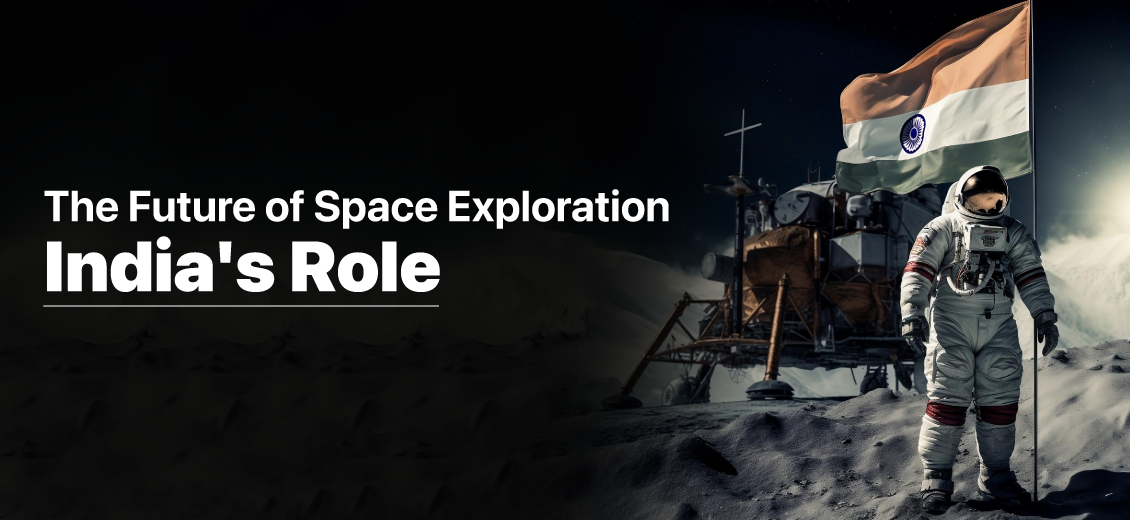The Future of Space Exploration: India's Role
Blogs Home
- 02 Sep 2023

Following the triumphant soft landing of Chandrayaan 3 on the lunar south pole last week, the Indian Space Research Organisation (ISRO) is poised for yet another monumental stride. Today, from the Satish Dhawan Space Centre in Sriharikota, ISRO is set to embark on the launch of the Aditya-L1 Mission. This historic mission heralds India's first venture into space-based solar observatories, aiming to study the Sun in unprecedented detail. As India now stands alongside the United States, Russia, and China as one of the selected few nations to achieve a successful lunar soft landing, it is evident that India is charting a bold trajectory in space exploration.
Introduction to India's Space Program
- In only six decades, India has rapidly ascended as a global frontrunner in space technology and exploration, with much credit attributed to the ISRO. The journey commenced in 1962 under the visionary guidance of Dr. Vikram Sarabhai, with the program initially falling under the purview of the Department of Atomic Energy. The overarching objective of India's space endeavour was to harness space technology for national progress, simultaneously pursuing scientific research in space and venturing into planetary exploration.
- ISRO's remarkable track record is a living testament to its accomplishments. The cadre of engineers and scientists at ISRO has crafted an array of launch vehicles, homegrown satellites, and associated technologies that cater to diverse domains such as Earth observation, communication, navigation, meteorology, and space science. Pivotal milestones encompass the creation and launch of the Indian National Satellite System (INSAT) to satisfy the telecommunications, broadcasting, meteorology, and search and rescue needs of India, the series of Indian Remote Sensing Satellites (IRS) catering to the needs of the country in managing its natural resources, and the development and deployment of the Polar Satellite Launch Vehicle (PSLV) and the Geosynchronous Satellite Launch Vehicle (GSLV), enabling the launch of both domestic and international satellites.
- ISRO's laurels extend to space exploration as well, with feats like the Chandrayaan missions for lunar exploration, the Mars Orbiter Mission (Mangalyaan) in 2013—India's inaugural interplanetary expedition—and the initiation of AstroSat in 2015, marking the country's first dedicated astronomical pursuit.
- The celestial journey embarked upon by India finds its origins in studies undertaken in the 1920s by luminaries like S K Mitra, C V Raman, and Meghnad Saha. The 1960s witnessed the formal inauguration of India's space odyssey, materializing in the maiden rocket launch of 1963, steered by the guidance of Vikram Sarabhai. The inception of the Indian National Committee for Space Research (INCOSPAR), orchestrated by Pt. Jawaharlal Nehru and Vikram Sarabhai, eventually metamorphosed into the present-day ISRO in 1969.
- Through its historical timeline, ISRO scripted numerous technological breakthroughs and initiated the launch of indigenous spacefaring entities. Hallmarks include the maiden flight of Aryabhata in 1975, which etched India into the ranks of spacefaring nations; the deployment of Rohini Satellite (RS-1) in 1980, solidifying India's standing as the sixth such nation; and the resounding triumph of the Chandrayaan lunar venture in 2008 (As India's Chandrayaan-1 played a crucial role in the discovery of water molecules on the Moon.). The Mangalyaan in 2013 further consolidated ISRO's stature as the fourth space agency to reach Mars.
- While there have been intermittent setbacks, exemplified by the SLV-3 launch in 1979 and the heat shield separation incident during the PSLV-C39 mission in 2017, India's cosmic journey has been a repository of invaluable insights and profound scientific discoveries. The preceding half-century has sown the seeds for even loftier achievements, with India's audacious plans for human space voyages and an ongoing commitment to enriching the frontiers of space exploration.
Living up to its Reputation of Leading Cost-effective and Successful missions
ISRO's renown as a cost-effective and successful space agency has become a defining trait on the global stage. Through a strategic blend of innovation, frugality, and meticulous planning, ISRO consistently executes missions that meet its objectives while maintaining affordability.
- The core of ISRO's cost-effective approach lies in its attention to detail across the mission lifecycle. From concept to execution, ISRO engineers and scientists optimize designs, streamline processes, and maximize resource utilization, ensuring mission integrity within budget constraints.
- A critical element of ISRO's cost-effectiveness is its focus on in-house technology development and infrastructure. By nurturing indigenous capabilities, ISRO minimizes external dependence, reducing costs associated with technology acquisition and licensing while tailoring solutions to specific requirements.
- ISRO's modular design philosophy is another cornerstone of its cost-effective methodology. Standardized components and systems adaptable for various missions reduce development time and costs. This modularity enables swift assembly, integration, and testing, facilitating rapid responses to mission objectives.
- ISRO's workhorse launch vehicles, like the PSLV, are celebrated for cost-efficiency and reliability. Designed to carry multiple payloads in a single mission, they optimize resource use and lower launch costs.
- Collaboration is pivotal in ISRO's success. Partnering with educational institutions, research organizations, and private industry leverages diverse expertise and resources, fostering innovation, knowledge exchange, and cost-sharing.
Chandrayaan Mission 3 Success:
Traditionally, previous lunar missions gravitated toward the equatorial region due to its favourable conditions; however, Chandrayaan Mission 3 dared to navigate the formidable terrain of the lunar south pole. This calculated choice held remarkable importance. The lunar south pole introduces an entirely distinct and challenging landscape in comparison to the equatorial expanse. One of the defining characteristics of this region is the scarcity of sunlight, leading to the existence of perpetually dark zones where temperatures plummet to an astonishing -230 degrees Celsius. The absence of sunlight and the relentless cold pose formidable challenges to the operation of scientific instruments and the mission's overall sustainability.
In the midst of these challenges, the lunar south pole has the allure of invaluable insights. Its extreme and contrasting conditions, while posing hurdles for human exploration, also make it a repository of unique information about the early Solar System. The region's rugged surface and potential resource deposits beckon scientists and researchers to unravel the mysteries of its history and evolution, which could reshape our understanding of the cosmos. The invaluable data and experiences gained from this mission will have profound implications for humanity's ambitions beyond Earth, guiding the strategies and technologies needed to navigate the cosmos.
As Chandrayaan Mission 3 triumphantly forayed into this challenging realm, it built upon the foundation laid by India's prior lunar expeditions, namely Chandrayaan-1 and Chandrayaan-2.
Chandrayaan-1, launched in 2008, marked India's inaugural lunar exploration mission. It set out to create an intricate three-dimensional map of the lunar surface and engage in mineralogical mapping. Executed with the PSLV-C11 launch vehicle, Chandrayaan-1 yielded significant breakthroughs, including the detection of water and hydroxyl on the lunar terrain.
Chandrayaan-2, characterized by its Orbiter, Lander, and Rover, embarked on a mission to explore the lunar south pole. The GSLV MkIII-M1 launch vehicle facilitated its journey. While the lander and rover experienced partial success with a landing mishap, the Orbiter brilliantly executed its mission. Data collection by the Orbiter unveiled the presence of water signatures across various latitudes, fundamentally altering our comprehension of the Moon's composition and potential.
Prospects and Collaborations:
India's prospects in space exploration shine brightly, with an array of upcoming missions and collaborations poised to elevate the nation's standing on the global stage. Two missions that stand out with special emphasis are the Aditya L1 mission and the Gaganyaan mission.
The Aditya L1 mission holds great significance as India's inaugural space-based endeavour to study the Sun. Positioned at the Sun-Earth system's Lagrange point 1 (L1), approximately 1.5 million km from Earth, the spacecraft will be situated in a halo orbit, affording continuous observation of the Sun without eclipses. This unique vantage point enables real-time monitoring of solar activities and their effects on space weather. Aditya L1 carries seven payloads, designed to scrutinize the photosphere, chromosphere, and corona of the Sun, employing electromagnetic, particle, and magnetic field detectors. The mission's payload is expected to provide critical insights into coronal heating, coronal mass ejections, solar flares, and other solar phenomena, enhancing our comprehension of the Sun's dynamics and their implications.
The Gaganyaan mission marks India's ambitious endeavour to send humans into space. Aboard an Orbital Module (OM) comprising a Crew Module (CM) and a Service Module (SM), the mission prioritizes human safety through state-of-the-art avionics systems and innovative engineering solutions. The CM, designed for human habitation in space, ensures a secure environment for astronauts during the mission, while the SM supports the CM's functioning. The astronaut training facility in Bengaluru is a testament to India's commitment to thorough preparation, encompassing academic, physical fitness, and simulation-based training, among other components.
In addition to these missions, there is a lineup of forthcoming endeavours. The Lunar Polar Exploration (LUPEX) mission, a collaborative effort between ISRO and JAXA (Japan), is set to explore the lunar polar regions, focusing on permanently shaded areas. X-ray Polarimeter Satellite (XPoSat) and NASA-ISRO SAR (NISAR) will contribute to Earth observation and human spaceflight endeavours. Additionally, Shukrayaan 1, the mission to Venus, promises to unveil the secrets of our neighbouring planet.
Collaborations with international space agencies are a hallmark of India's approach to space exploration. These collaborations foster knowledge exchange, resource sharing, and the expansion of humanity's exploration horizon. By joining forces with other nations, India cements its role as a vital contributor to global scientific progress.
As we gaze into the future, the prospects are rife with promise. Upcoming missions such as Aditya L1 and Gaganyaan hold the potential to reshape our understanding of the cosmos, enhance technological capabilities, and solidify India's position as a prominent player in the realm of space exploration. The legacy of Chandrayaan Mission 3's success reverberates through these endeavours, propelling India toward even greater accomplishments and fostering collaboration that transcends borders, ideologies, and the limits of our terrestrial realm.
Sources:
- https://www.isro.gov.in/media_isro/pdf/ResourcesPdf/SpaceIndia/Space%20India%20Sep%202013-Dec%202014.pdf
- https://www.isro.gov.in/Aditya_L1.html
- https://www.isro.gov.in/Gaganyaan.html
- https://www.drishtiias.com/daily-updates/daily-news-analysis/chandrayaan-3-2
- https://www.drishtiias.com/daily-updates/daily-news-analysis/chandrayaan-3-successfully-lands-on-moon-s-south-pole
- https://www.indiascience.in/videos/isro-indias-space-journey-e-2#:~:text=In%20less%20than%2060%20years,the%20Department%20of%20Atomic%20energy.
- https://cmr.earthdata.nasa.gov/search/concepts/C1214591063-SCIOPS.html
- https://asean-iit.in/history-of-indias-space-journey/
- https://economictimes.indiatimes.com/news/science/the-secret-behind-indias-budget-friendly-moonshots-how-isro-has-developed-its-low-cost-edge/articleshow/103018475.cms?from=mdr
- https://timesofindia.indiatimes.com/india/chandrayaan-3-isros-upcoming-and-past-space-missions/articleshow/103234864.cms
Priyanka Todariya

Priyanka Todariya is a Public Administration post-graduate and an experienced communications professional who has extensively worked for several government entities like Ministry of Jal Shakti, Ministry of Skill Development and Entrepreneurship, National Skill Development Corporation (NSDC) and state governments like Uttar Pradesh and Gujarat.
Blogs Home



